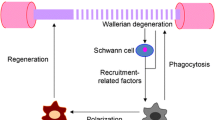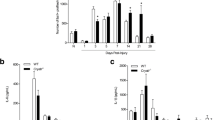Abstract
Molecular mechanisms of myelin removal by macrophages were explored by examining the immunophenotypes of macrophages following injury of rat sciatic nerve, using a combined method of immunohistochemistry and confocal laser microscopy. In the crush injury model, the involvement in myelin clearance of a cytoplasmic antigen specific for monocytes/macrophages, ED1, was evident. The obvious recruitment of ED1-immunoreactive (-ir) cells was detected first at the crush injury site and then in the distal stump within which Wallerian degeneration had occurred. Double labelling revealed that the ED1-ir cells, except for monocyte-like round cells, always phagocytosed myelin basic protein-ir myelin debris. On the other hand, the expression of ED2, a surface antigen specific for resident macrophages, was significantly different; ED2-ir cells also increased while myelin removal was progressing from day 3 to day 7, but only some of the cells were engaged in myelin phagocytosis. The poor capacity of myelin phagocytosis by ED2-ir cells was supported by the transection model, in which the proximal stump was ligated to suppress regeneration. ED2 may be involved in events other than myelin removal, providing a local environment conducive to axonal regeneration. Our findings thus seem to suggest that ED1 is one of the most reliable markers for cells carrying out myelin phagocytosis, whereas ED2 may participate in entirely different functions. The expression of complement receptor type 3, OX42, was similar to that of ED1 in terms of the swift recruitment of immunopositive cells, their distribution with close association to myelin debris and their high phagocytotic capacity. This supports previously reported in vitro evidence that myelin phagocytosis by macrophages may be complement-mediated.
Similar content being viewed by others
References
Avellino, A. M., Hart, D., Dailey, A. T., Mackinnon, D. M., Ellegala, D. & Kliot, M. (1995) Differential macrophage responses in the peripheral and central nervous system duringWallerian degeneration of axons. Experimental Neurology 136, 189–198.
Baichwal, R. R., Bigbee, J. W. & Devries, G. H. (1988) Macrophage-mediated myelin-related mitogenic factor for cultured Schwann cells. Proceedings of the National Academy of Sciences (USA) 85, 1701–1705.
Barbara, A., Pierre, S. & Tidball J. G. (1994) Differential response of macrophage subpopulation to soleus muscle reloading after rat hindlimb suspension. Journal of Applied Physiology 77, 290–297.
Barb ´e, E., Damoiseaux, J. G. M. C., Dopp, E. A. & Dijkstra, C. D. (1990) Characterization and expression of the antigen present on resident rat macrophages recognized by monoclonal antibody ED2. Immunobiology 182, 88–99.
Bauer, J., Sminia, T., Wouterlood, F. G. & Dijkstra, C. D. (1994) Phagocytic activity of macrophages and microglial cells during the course of acute and chronic relapsing experimental autoimmune encephalomyelitisq. Journal of Neuroscience Research 38, 365–375.
Beuche, W. & Friede, R. L. (1984) The role of nonresident cells in Wallerian degeneration. Journal of Neurocytology 13, 767–796.
Br ¬u ck, W. & Friede, R. L. (1990) Anti-macrophage CR3 antibody blocks myelin phagocytosis by macrophages in vitro. Acta Neuropathologica 80, 415–418.
Br ¬u ck, W. & Friede, R. L. (1991) The role of complement in myelin phagocytosis during PNS Wallerian degeneration. Journal of the Neurological Sciences 103, 182–187.
Br ¬u ck, W. (1997) The role of macrophages in Wallerian degeneration. Brain Pathology 7, 741–752.
Dejong, B. A. & Smith, M. E. (1997) A role for complement in phagocytosis of myelin. Neurochemical Research 22, 491–498.
Dijkstra, C. D., D¬o pp, E. A., Joling, P. & Kraal G. (1985) The heterogeneity of mononuclear phagocytes in lymphoid organs: distinct macrophage subpopulations in the rat recognized by monoclonal antibodies ED1, ED2 and ED3. Immunology 54, 589–599.
FernandeZ-valle, C., Bunge, R. P. & Bunge, M. B. (1995) Schwann cells degradate myelin and proliferate in the absence of macrophages: evidence fromin vitro studies of Wallerian degeneration. Journal of Neurocytology 24, 667–679.
Han, M. H., Piao, Y. J., Guo, D. W. & Ogawa, K. (1989) The role of Schwann cells and macrophages in the removal of myelin during Wallerian degeneration. Acta Histochemica et Cytochemica 22, 161–172.
Heumann, R., Lindholm, D., Bandtlow, C., Meyer, M., Radeke, M. J., Misko, T. P., Shooter, E. & Thoenen, H. (1987) Differential regulation of mRNA encoding nerve growth factor and its receptor in rat sciatic nerve during development, degeneration, and regeneration: Role of macrophages. Proceedings of the National Academy of Sciences (USA) 84, 8735–8739.
Lindholm, D., Heumann, R., Hengerer, B. & Thoenen, H. (1988) Interleukin 1 increases stability and transcription of mRNA encoding nerve growth factor in cultured rat fibroblasts. Journal of Biological Chemistry 263, 16348–16351.
Liu, H. M., Yan L. H. & Yang, Y. J. (1995) Schwann cell properties: 3. C-fos expression, bFGF production, phagocytosis and proliferation duringWallerian degeneration. Journal of Neuropathology and Experimental Neurology 54, 487–496.
Martinet, Y., Bitterman, P. B., Mornex, J.-F., Grotendorst, G. R., Martin, G. R. & Crystal, R. G. (1986) Activated human monocytes express the c-sis proto-oncogene and release a mediator showing PDGF-like activity. Nature 319, 158–160.
Martini, R. (1994) Expression and functional roles of neural cell surface molecules and extracellular matrix components during development and regeneration of peripheral nerves. Journal of Neurocytology 23, 1–28.
Mclennan, I. S. (1993) Resident macrophages (ED2-and ED3-positive) do not phagocytose degenerating rat skeletal muscle fibres. Cell and Tissue Research 272, 193–196.
Mclennan, I. S. (1996) Degenerating and regenerating skeletal muscles contain several subpopulations of macrophages with distinct spatial and temporal distributions. Journal of Anatomy 188, 17–28.
Mcmaster, W. R. & Williams, A. F. (1979) Identification of Ia glycoproteins in rat thymus and purification from rat spleen. European Journal of Immunology 9, 426–433.
Monaco, S., Gehrmann, J., Raivich, G. & Kreutzberg, G. W. (1992) MHC-positive, ramified macrophages in the normal and injured rat peripheral nervous system. Journal of Neurocytology 21, 623–634.
Oõ daly, J. A. & Imaeda, T. (1967) Electron microscopic study of Wallerian degeneration in cutaneous nerves caused by mechanical injury. Laboratory Investigation 17, 744–766.
Olsson, Y. & Sj ¬o strand, J. (1969) Origin of macrophages in Wallerian degeneration of peripheral nerves demonstrated autoradiographically. Experimental Neurology 23, 102–112.
Perry, V. H. (1994) Macrophages in peripheral nerve repair. Macrophages and the Nervous System, Austin: R.G. Landes Company, pp. 102–118.
Perry, V. H., Brown, M. C. & Gordon S. (1987) The macrophage response to central and peripheral nerve injury-A possible role for macrophages in regenerationq. Journal of Experimental Medicine 165, 1218–1223.
Reichert, F., Saada, A. & Rotshenker, S. (1994) Peripheral nerve injury induces Schwann cells to express two macrophage phenotypes: Phagocytosis and the galactose-specific lectin MAC-2. Journal of Neuroscience 14, 3231–3245.
Robinson, A. P., White, T. M. & Mason, D. W. (1986) Macrophage heterogeneity in the rat as delineated by two monoclonal antibodies MRC OX-41 and MRC OX-42, the latter recognizing complement receptor type 3. Immunology 57, 239–247.
Scheidt, P. & Friede, R. L. (1987) Myelin phagocytosis in Wallerian degeneration: Properties of millipore diffusion chambers and immunohistochemical identification of cell populations. Acta Neuropathologica 75, 77–84.
Schober, A., Huber, K., Fey, J. & Unsicker, K. (1998) Distinct populations of macrophages in the adult rat adrenal gland: a subpopulation with neurotrophin-4-like immunoreactivity. Cell and Tissue Research 291, 365–373.
Snipes, G. J., Mcguire, C. G., Norden, J. J. & Freeman, J. A. (1986) Nerve injury stimulates the secretion of apolipoprotein E by nonneuronal cells. Proceedings of the National Academy of Sciences (USA) 83, 1130–1134.
Stoll, G., Griffin, J. W., Li, C. Y. & Trapp, B. D. (1989) Wallerian degeneration in the peripheral nervous system: participation of both Schwann cells and macrophages in myelin degradation. Journal of Neurocytology 18, 671–683.
Author information
Authors and Affiliations
Rights and permissions
About this article
Cite this article
Hirata, K., Mitoma, H., Ueno, N. et al. Differential response of macrophage subpopulations to myelin degradation in the injured rat sciatic nerve. J Neurocytol 28, 685–695 (1999). https://doi.org/10.1023/A:1007012916530
Issue Date:
DOI: https://doi.org/10.1023/A:1007012916530




